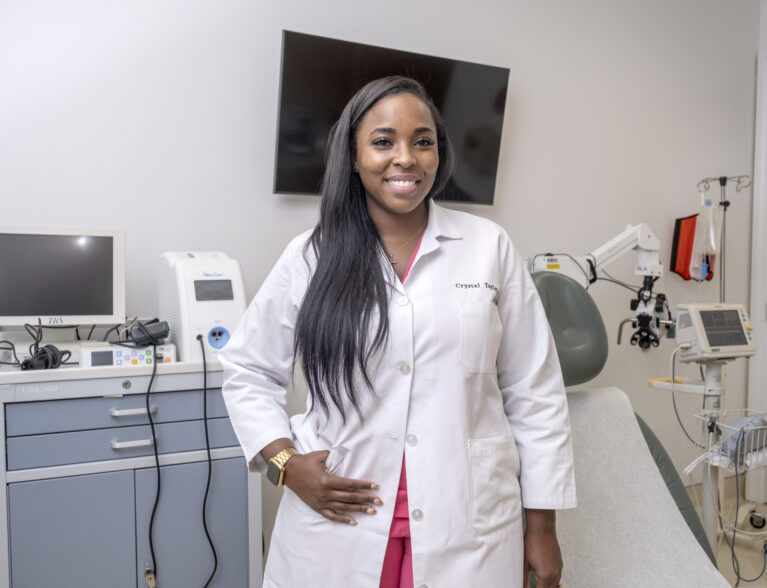
In the not-too-distant past, many women requiring a hysterectomy to remove their uterus were forced to carry the scars from open or laparoscopic surgical approaches through the abdomen. Over the years, however, advancements in surgical techniques have led to the development of minimally invasive approaches to hysterectomy including traditional laparoscopic procedures.
Now, the American College of Obstetrics and Gynecologists (ACOG) recommends a more advanced vaginal hysterectomy option whenever possible because it doesn’t create any external scars and provides a shorter hospital stay and faster recovery.
“The newest minimally invasive hysterectomy procedure allows us to use the vagina – our body’s natural opening – to remove the uterus, fallopian tubes and ovaries,” said obstetrician and gynecologist Dr. Crystal Taylor of Cleveland Clinic Indian River Hospital’s Partners in Women’s Health. “While we’ve always done this vaginally as long as the patient was a good candidate, thanks to the new advances and technology the laparoscopy that we normally use to inflate the abdomen is now inserted into the vagina to perform the procedure. Since we are not going through the abdomen at all, there are no visible scars on the belly whatsoever.”
The vaginal procedure is performed under general anesthesia in a hospital setting and is completed in 45 minutes to 2 hours.
“Basically, we place a little device through the vagina that insufflates the abdomen like a balloon,” Dr. Taylor explained. “This creates extra space for the surgeon to access and remove the cervix and uterus and extract them through the vagina. If you need your tubes and ovaries removed, they also can be removed through the vagina without having to additional incisions.”
The device has a high-definition camera that projects onto a screen in the operating room, providing a magnified view of the surgical path. Miniature surgical instruments are inserted through the device and used to extract the reproductive organs without any external incisions.
“Most patients go home the same day of the surgery with little postoperative pain and will be back to their normal routine within a week or two,” Dr. Taylor continued. “We still advise that they abstain from sex and put nothing in the vagina for six weeks so the vaginal incision can heal. That means no tampons, no Jacuzzis, no beaches, no pools – nothing that can allow bacteria into the incision.”
The ideal candidate for the newer vaginal hysterectomy procedure is a woman who had a child via vaginal delivery and has had limited abdominal surgery that may have left any scar tissue adhesions. She should also not have a lot of fibroids because fibroids can cause the abnormal bleeding.
“We do an Ultrasound to determine if you are a candidate,” Dr. Taylor said. “In the past, if you were bleeding from the uterus, we would just take the uterus out, but now we have different ways to treat abnormal bleeding other than a hysterectomy. We might be able to fix the problem with birth control pills, an IUD, or the burning of the uterus with an ablation. Many patients don’t want to take the alternate route and just want a definitive solution to management. Once we have established that you need a hysterectomy, we can talk about the different ways to perform the surgery.”
Risks associated with the procedure are post-operative pain, bleeding, infection, and damage to surrounding structures like bowel and bladder, but these unwanted aftereffects are rare.
Still, many patients are concerned about the effects removal of the uterus will have on their overall health.
“The only function of the uterus is to carry a child, so obviously the woman will not be able to become pregnant after a hysterectomy,” Dr. Taylor said. “If we don’t take out the ovaries, her hormonal levels remain the same and won’t affect her overall health. The ovaries are the source of estrogen and youthfulness, so once they are removed, she will become menopausal.”
According to the Centers for Disease Control and Prevention, approximately 600,000 hysterectomies are performed in the United States each year. Nearly 68 percent are done for benign conditions that involve abnormal bleeding, uterine fibroids and endometriosis, and in some cases vaginal or rectal prolapse.
Minimally invasive techniques have revolutionized the field of gynecological surgery with improved patient outcomes, reduced pain and faster recovery times. With advancements in technology and surgical expertise, the landscape of minimally invasive hysterectomy continues to evolve, promising even better outcomes for patients in the future.
Dr. Crystal Taylor earned her undergraduate and medical degrees at Florida State University and completed her residency at the University of Texas Health Science Center at Houston. She is a member of the American College of Obstetrics and Gynecology. Dr. Taylor and all the providers at Cleveland Clinic Indian River Hospital’s Partners for Women’s Health are skilled in this procedure and are now accepting new patients at their offices located at 1050 37th Place, Suite 101. To schedule an appointment call 772-770-6116.



